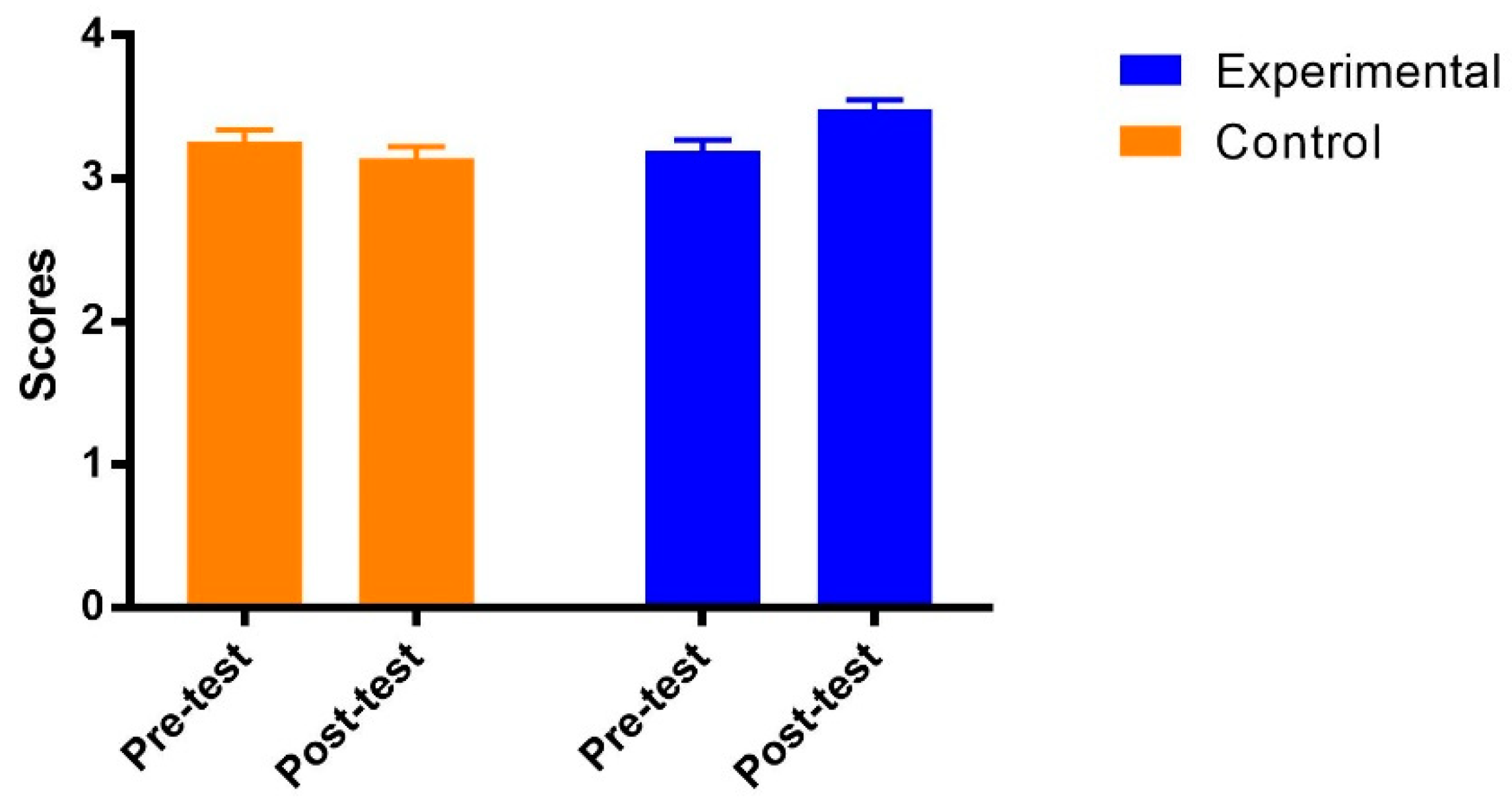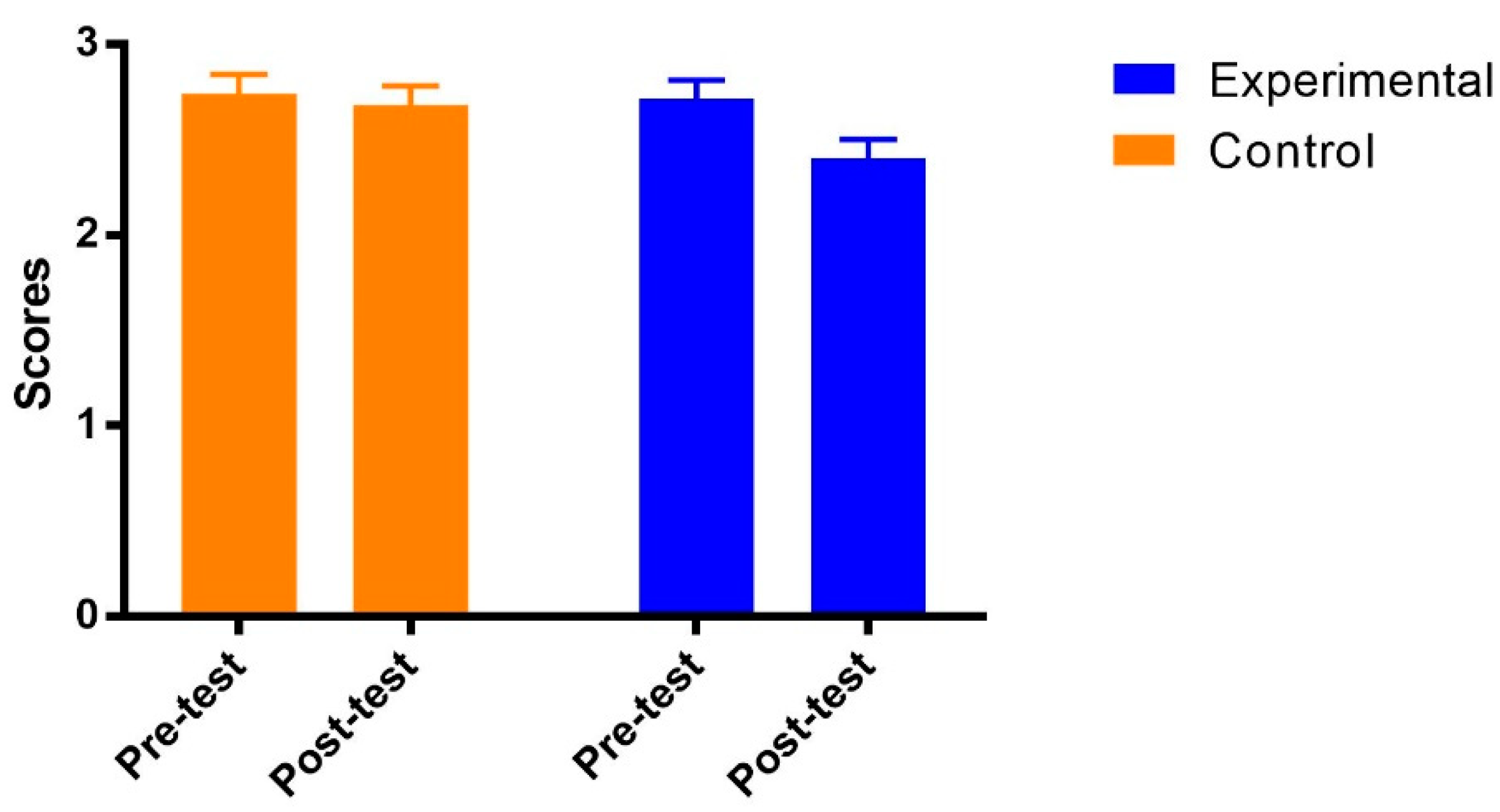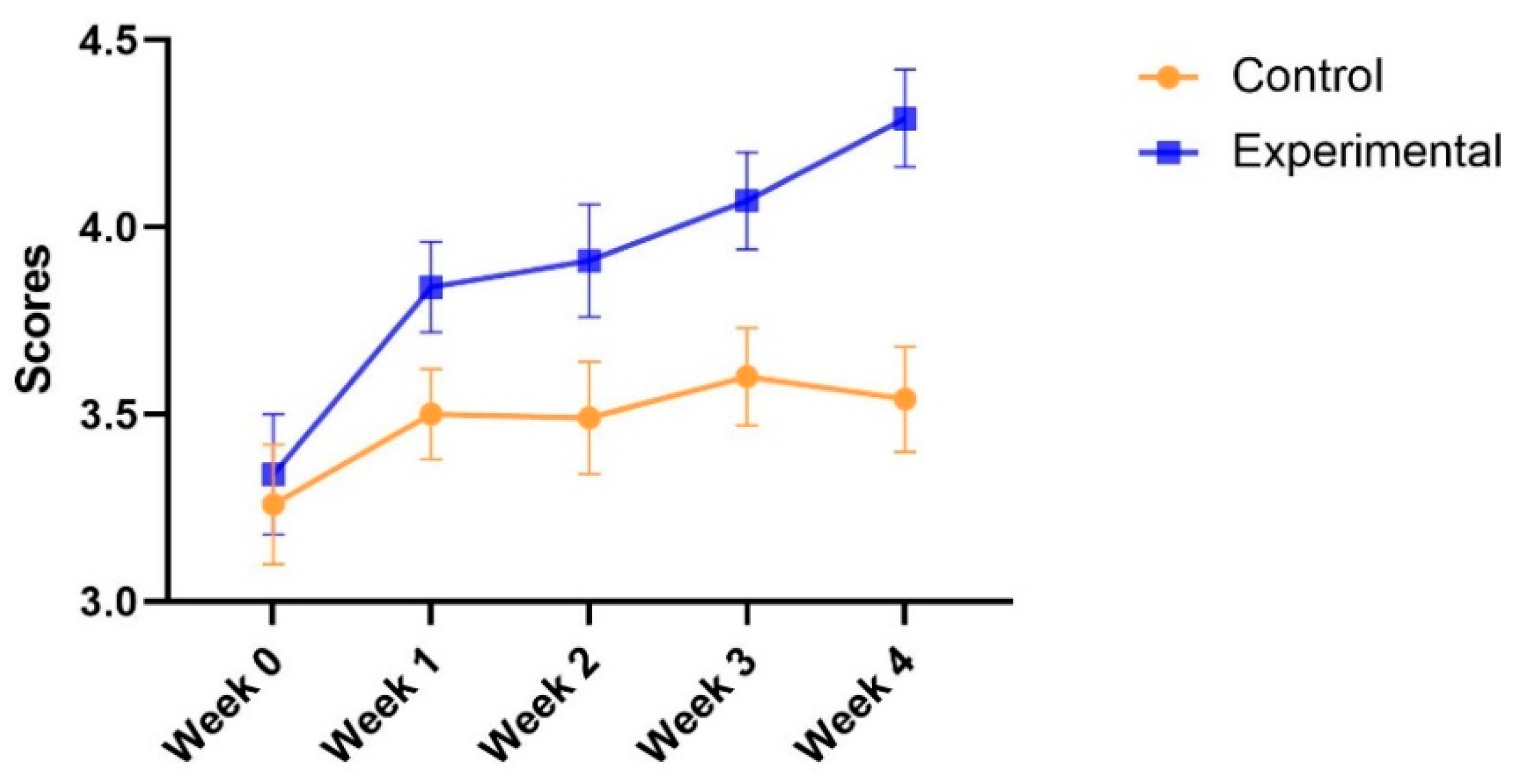Exposure to Nature Sounds through a Mobile Application in Daily Life: Effects on Learning Performance among University Students
Abstract
1. Introduction
1.1. Impact of Exposure to Nature (Including Nature Sounds)
1.2. Potential Impact of Exposure to Nature (Including Nature Sounds) on Learning
1.3. The Present Study
2. Method
2.1. Participants
2.2. Measures
2.2.1. Engagement in Deep Learning
2.2.2. Academic Procrastination
2.2.3. Academic Self-Efficacy
2.2.4. Weekly Reports and Comments
2.3. Procedure
2.4. Data Analysis
3. Results
3.1. Engagement in Deep Learning
3.2. Academic Procrastination
3.3. Academic Self-Efficacy
3.4. Weekly Reports and Students’ Perceptions
4. Discussion
4.1. Engagement in Deep Learning
4.2. Academic Procrastination
4.3. Academic Self-Efficacy
5. Conclusions
Author Contributions
Funding
Institutional Review Board Statement
Informed Consent Statement
Data Availability Statement
Acknowledgments
Conflicts of Interest
References
- Abbott, L.C. The Influence of Natural Sounds on Attention Restoration; The Pennsylvania State University: State College, PA, USA, 2015. Available online: https://etda.libraries.psu.edu/catalog/26421 (accessed on 2 November 2019).
- Stieger, S.; Aichinger, I.; Swami, V. The impact of nature exposure on body image and happiness: An experience sampling study. Int. J. Environ. Health Res. 2020, 32, 870–888. [Google Scholar] [CrossRef] [PubMed]
- Sweller, J. Cognitive load theory, learning difficulty, and instructional design. Learn. Instr. 1994, 4, 295–312. [Google Scholar] [CrossRef]
- van Merriënboer, J.J.G.; Sweller, J. Cognitive load theory and complex learning: Recent developments and future directions. Educ. Psychol. Rev. 2005, 17, 147–177. [Google Scholar] [CrossRef]
- Di, Z.; Gong, X.; Shi, J.; Ahmed, H.O.A.; Nandi, A.K. Internet addiction disorder detection of Chinese college students using several personality questionnaire data and support vector machine. Addict. Behav. Rep. 2019, 10, 100200. [Google Scholar] [CrossRef]
- Lu, J.; Luo, J.; Liang, L.Y.; Jing, M. Measuring Adolescents’ Social Media Behavior Outside and Inside of School: Development and Validation of Two Scales. J. Educ. Comput. Res. 2018, 57, 1108–1130. [Google Scholar] [CrossRef]
- Luo, J.; Yeung, P.-S.; Li, H. Impact of media multitasking on executive function in adolescents: Behavioral and self-reported evidence from a one-year longitudinal study. Internet Res. 2022, 32, 1310–1328. [Google Scholar] [CrossRef]
- Wong, P.P.Y.; Wong, G.W.C.; Techanamurthy, U.; Mohamad, W.S.B.; Febriana, A.; Chong, J.C.M. Using social mobile learning to stimulate idea generation for collective intelligence among higher education students. Knowl. Manag. E-Learn. 2022, 14, 150–169. [Google Scholar] [CrossRef]
- Xie, J.; Wang, M.; Hooshyar, D. Student, parent, and teacher perceptions towards digital educational games: How they differ and influence each other. Knowl. Manag. E-Learn. 2021, 13, 142–160. [Google Scholar] [CrossRef]
- Young, K.S. Internet addiction: The emergence of a new clinical disorder. CyberPsychol. Behav. 1998, 1, 237–244. [Google Scholar] [CrossRef]
- Abraham, A.; Sommerhalder, K.; Abel, T. Landscape and well-being: A scoping study on the health-promoting impact of outdoor environments. Int. J. Public Heal. 2009, 55, 59–69. [Google Scholar] [CrossRef]
- Bowler, D.E.; Buyung-Ali, L.M.; Knight, T.M.; Pullin, A.S. A systematic review of evidence for the added benefits to health of exposure to natural environments. BMC Public Health 2010, 10, 456. [Google Scholar] [CrossRef] [PubMed]
- Jo, H.; Song, C.; Ikei, H.; Enomoto, S.; Kobayashi, H.; Miyazaki, Y. Physiological and Psychological Effects of Forest and Urban Sounds Using High-Resolution Sound Sources. Int. J. Environ. Res. Public Heal. 2019, 16, 2649. [Google Scholar] [CrossRef] [PubMed]
- Kondo, M.C.; Jacoby, S.F.; South, E.C. Does spending time outdoors reduce stress? A review of real-time stress response to outdoor environments. Heal. Place 2018, 51, 136–150. [Google Scholar] [CrossRef] [PubMed]
- Li, D.; Sullivan, W.C. Impact of views to school landscapes on recovery from stress and mental fatigue. Landsc. Urban Plan. 2016, 148, 149–158. [Google Scholar] [CrossRef]
- Song, C.; Ikei, H.; Miyazaki, Y. Physiological Effects of Visual Stimulation with Forest Imagery. Int. J. Environ. Res. Public Heal. 2018, 15, 213. [Google Scholar] [CrossRef]
- Luo, J.; Wang, M.; Chen, L. The Effects of Using a Nature-Sound Mobile Application on Psychological Well-Being and Cognitive Performance Among University Students. Front. Psychol. 2021, 12, 699908. [Google Scholar] [CrossRef]
- Ulrich, R.S. Aesthetic and affective response to natural environment. In Behavior and the Natural Environment; Altman, I., Wohlwill, J.F., Eds.; Springer: Berlin/Heidelberg, Germany, 1983; pp. 85–125. [Google Scholar]
- Ulrich, R.S.; Simons, R.F.; Losito, B.D.; Fiorito, E.; Miles, M.A.; Zelson, M. Stress recovery during exposure to natural and urban environments. J. Environ. Psychol. 1991, 11, 201–230. [Google Scholar] [CrossRef]
- Kaplan, S. The restorative benefits of nature: Toward an integrative framework. J. Environ. Psychol. 1995, 15, 169–182. [Google Scholar] [CrossRef]
- Kaplan, R.; Kaplan, S. The Experience of Nature: A Psychological Perspective; Cambridge University Press: Cambridge, UK, 1989. [Google Scholar]
- Berman, M.G.; Jonides, J.; Kaplan, S. The Cognitive Benefits of Interacting with Nature. Psychol. Sci. 2008, 19, 1207–1212. [Google Scholar] [CrossRef]
- Berto, R. Exposure to restorative environments helps restore attentional capacity. J. Environ. Psychol. 2005, 25, 249–259. [Google Scholar] [CrossRef]
- Berto, R. The Role of Nature in Coping with Psycho-Physiological Stress: A Literature Review on Restorativeness. Behav. Sci. 2014, 4, 394–409. [Google Scholar] [CrossRef] [PubMed]
- Hamann, G.A.; Ivtzan, I. 30 Minutes in Nature a Day Can Increase Mood, Well-Being, Meaning in Life and Mindfulness: Effects of a Pilot Programme. Soc. Inq. Well-Being 2016, 2, 34–46. [Google Scholar] [CrossRef]
- Hartig, T.; Evans, G.W.; Jamner, L.D.; Davis, D.S.; Gärling, T. Tracking restoration in natural and urban field settings. J. Environ. Psychol. 2003, 23, 109–123. [Google Scholar] [CrossRef]
- Largo-Wight, E.; O’Hara, B.K.; Chen, W.W. The efficacy of a brief nature sound intervention on muscle tension, pulse rate, and self-reported Stress: Nature contact micro-break in an office or waiting room. Health Environ. Res. Des. J. 2016, 10, 45–51. [Google Scholar] [CrossRef] [PubMed]
- Barton, R. Sounds of Nature: What Influences of Nature-Based and Non-Nature-Sounds? University of Surrey: Guildford, UK, 2018. [Google Scholar] [CrossRef]
- Van Hedger, S.C.; Nusbaum, H.C.; Clohisy, L.; Jaeggi, S.M.; Buschkuehl, M.; Berman, M.G. Of cricket chirps and car horns: The effect of nature sounds on cognitive performance. Psychon. Bull. Rev. 2019, 26, 522–530. [Google Scholar] [CrossRef] [PubMed]
- Ruvimova, A.; Kim, J.; Fritz, T.; Hancock, M.; Shepherd, D.C. “Transport me away”: Fostering flow in open offices through virtual reality. In Proceedings of the 2020 CHI Conference on Human Factors in Computing Systems, Honolulu, HI, USA, 25–30 April 2020; pp. 1–14. [Google Scholar] [CrossRef]
- Schatz, M. The Effect of Virtual Reality on Creativity: Evaluating the Impact of a Nature Environment via Interactive Displays on Creativity; Cornell University: Ithaca, NY, USA, 2019. [Google Scholar] [CrossRef]
- Csikszentmihalyi, M. Flow: The Psychology of Optimal Performance; Harper and Row: New York, NY, USA, 1990. [Google Scholar]
- Bruer, J.T. Education and the Brain: A Bridge Too Far. Educ. Res. 1997, 26, 4–16. [Google Scholar] [CrossRef]
- Horvath, J.C.; Donoghue, G.M. A Bridge Too Far—Revisited: Reframing Bruer’s Neuroeducation Argument for Modern Science of Learning Practitioners. Front. Psychol. 2016, 7, 377. [Google Scholar] [CrossRef]
- Szucs, D.; Goswami, U. Definition and Role of an Emerging Discipline. Mind Brain Educ. 2007, 1, 114–127. [Google Scholar] [CrossRef]
- Lee, K.E.; Williams, K.J.; Sargent, L.D.; Williams, N.S.; Johnson, K.A. 40-second green roof views sustain attention: The role of micro-breaks in attention restoration. J. Environ. Psychol. 2015, 42, 182–189. [Google Scholar] [CrossRef]
- Ratcliffe, E. Sound and Soundscape in Restorative Natural Environments: A Narrative Literature Review. Front. Psychol. 2021, 12, 570563. [Google Scholar] [CrossRef]
- Browning, M.H.E.M.; Rigolon, A. School Green Space and Its Impact on Academic Performance: A Systematic Literature Review. Int. J. Environ. Res. Public Health 2019, 16, 429. [Google Scholar] [CrossRef] [PubMed]
- Matsuoka, R.H. Student performance and high school landscapes: Examining the links. Landsc. Urban Plan. 2010, 97, 273–282. [Google Scholar] [CrossRef]
- Wu, C.-D.; McNeely, E.; Cedeño-Laurent, J.G.; Pan, W.-C.; Adamkiewicz, G.; Dominici, F.; Lung, S.-C.C.; Su, H.-J.; Spengler, J.D. Linking Student Performance in Massachusetts Elementary Schools with the “Greenness” of School Surroundings Using Remote Sensing. PLoS ONE 2014, 9, e108548. [Google Scholar] [CrossRef] [PubMed]
- Kuo, M.; Browning, M.H.E.M.; Sachdeva, S.; Lee, K.; Westphal, L. Might school performance grow on trees? Examining the link between “Greenness” and academic achievement in Urban, high-poverty schools. Front. Psychol. 2018, 9, 01669. [Google Scholar] [CrossRef]
- Kweon, B.-S.; Ellis, C.D.; Lee, J.; Jacobs, K. The link between school environments and student academic performance. Urban For. Urban Green. 2017, 23, 35–43. [Google Scholar] [CrossRef]
- Li, D.; Chiang, Y.-C.; Sang, H.; Sullivan, W.C. Beyond the school grounds: Links between density of tree cover in school surroundings and high school academic performance. Urban For. Urban Green. 2019, 38, 42–53. [Google Scholar] [CrossRef]
- Kuo, M.; Browning, M.H.E.M.; Penner, M.L. Do Lessons in Nature Boost Subsequent Classroom Engagement? Refueling Students in Flight. Front. Psychol. 2018, 8, 2253. [Google Scholar] [CrossRef]
- van den Berg, A.E.; Wesselius, J.E.; Maas, J.; Tanja-Dijkstra, K. Green Walls for a Restorative Classroom Environment: A Controlled Evaluation Study. Environ. Behav. 2017, 49, 791–813. [Google Scholar] [CrossRef]
- Biggs, J. Student Approaches to Learning and Studying; Australian Council for Education Research: Hawthorn, Australia, 1987. [Google Scholar]
- Biggs, J. What do inventories of students’ learning process really measure? A theoretical review and clarification. Br. J. Educ. Psychol. 1993, 83, 3. [Google Scholar] [CrossRef]
- Biggs, J.; Kember, D.; Leung, D.Y. The revised two-factor Study Process Questionnaire: R-SPQ-2F. Br. J. Educ. Psychol. 2001, 71, 133–149. [Google Scholar] [CrossRef]
- Kusurkar, R.A.; Croiset, G.; Galindo-Garré, F.; Ten Cate, O. Motivational profiles of medical students: Association with study effort, academic performance and exhaustion. BMC Med. Educ. 2013, 13, 87. [Google Scholar] [CrossRef] [PubMed]
- Kaplan, S.; Berman, M.G. Directed Attention as a Common Resource for Executive Functioning and Self-Regulation. Perspect. Psychol. Sci. 2010, 5, 43–57. [Google Scholar] [CrossRef] [PubMed]
- Bakir-Demir, T.; Berument, S.K.; Sahin-Acar, B. The relationship between greenery and self-regulation of children: The mediation role of nature connectedness. J. Environ. Psychol. 2019, 65, 101327. [Google Scholar] [CrossRef]
- Beute, F.; de Kort, Y.A.W. Natural resistance: Exposure to nature and self-regulation, mood, and physiology after ego-depletion. J. Environ. Psychol. 2014, 40, 167–178. [Google Scholar] [CrossRef]
- Weeland, J.; Moens, M.A.; Beute, F.; Assink, M.; Staaks, J.P.; Overbeek, G. A dose of nature: Two three-level meta-analyses of the beneficial effects of exposure to nature on children’s self-regulation. J. Environ. Psychol. 2019, 65, 101326. [Google Scholar] [CrossRef]
- Pychyl, T.A.; Flett, G.L. Procrastination and Self-Regulatory Failure: An Introduction to the Special Issue. J. Ration. Cogn. Ther. 2012, 30, 203–212. [Google Scholar] [CrossRef]
- Rozental, A.; Carlbring, P. Understanding and Treating Procrastination: A Review of a Common Self-Regulatory Failure. Psychology 2014, 5, 1488–1502. [Google Scholar] [CrossRef]
- Steel, P. The nature of procrastination: A meta-analytic and theoretical review of quintessential self-regulatory failure. Psychol. Bull. 2007, 133, 65–94. [Google Scholar] [CrossRef]
- Tao, X.; Hanif, H.; Ahmed, H.H.; Ebrahim, N.A. Bibliometric Analysis and Visualization of Academic Procrastination. Front. Psychol. 2021, 12, 722332. [Google Scholar] [CrossRef]
- Ruiz-Gallardo, J.-R.; Verde, A.; Valdés, A. Garden-Based Learning: An Experience with “At Risk” Secondary Education Students. J. Environ. Educ. 2013, 44, 252–270. [Google Scholar] [CrossRef]
- Bandura, A. Self-efficacy: Toward a unifying theory of behavioral change. Adv. Behav. Res. Ther. 1978, 1, 139–161. [Google Scholar] [CrossRef]
- Elias, S.M.; MacDonald, S. Using Past Performance, Proxy Efficacy, and Academic Self-Efficacy to Predict College Performance. J. Appl. Soc. Psychol. 2007, 37, 2518–2531. [Google Scholar] [CrossRef]
- Richardson, M.; Abraham, C.; Bond, R. Psychological correlates of university students’ academic performance: A systematic review and meta-analysis. Psychol. Bull. 2012, 138, 353–387. [Google Scholar] [CrossRef] [PubMed]
- Schouwenrg, H.C. Academic procrastionation: Theoretical notions, measurement, and research. In Procrastination and Task Avoidance: Theory, Research, and Treatment; Ferrari, J.R., Johnson, J.L., McCown, W.G., Eds.; Springer Science: Berlin/Heidelberg, Germany, 1995; pp. 71–96. [Google Scholar]
- Pintrich, P.R.; Smith, D.A.F.; Garcia, T.; McKeachie, W.J. Reliability and Predictive Validity of the Motivated Strategies for Learning Questionnaire (Mslq). Educ. Psychol. Meas. 1993, 53, 801–813. [Google Scholar] [CrossRef]
- Kushlev, K.; Dunn, E.W. Checking email less frequently reduces stress. Comput. Hum. Behav. 2015, 43, 220–228. [Google Scholar] [CrossRef]
- Engeser, S.; Rheinberg, F. Flow, performance and moderators of challenge-skill balance. Motiv. Emot. 2008, 32, 158–172. [Google Scholar] [CrossRef]
- Chen, J.; Wang, M.; Grotzer, T.A.; Dede, C. Using a three-dimensional thinking graph to support inquiry learning. J. Res. Sci. Teach. 2018, 55, 1239–1263. [Google Scholar] [CrossRef]
- Leiter, M.P. Burn-out as a crisis in self-efficacy: Conceptual and practical implications. Work Stress 1992, 6, 107–115. [Google Scholar] [CrossRef]





| Measures | Group | Pre-Test | Post-Test | ||
|---|---|---|---|---|---|
| Mean | SD | Mean | SD | ||
| Deep learning | Experimental group | 3.19 | 0.09 | 3.48 | 0.08 |
| Control group | 3.26 | 0.06 | 3.14 | 0.07 | |
| Academic procrastination | Experimental group | 2.71 | 0.10 | 2.40 | 0.10 |
| Control group | 2.74 | 0.10 | 2.68 | 0.11 | |
| Academic self-efficacy | Experimental group | 3.09 | 0.10 | 3.16 | 0.09 |
| Control group | 3.20 | 0.10 | 2.94 | 0.10 | |
| Time | Adjusted Estimated Means (SE) | Comparisons | |
|---|---|---|---|
| Experimental | W0 | 3.19 (0.15) | W0 = W1, W0 < W2 **, W0 < W3 **, W0 < W4 *** |
| W1 | 3.06 (0.13) | W1 < W2 *, W1 < W3 *, W1 < W4 ** | |
| W2 | 2.72 (0.12) | W2 = W3, W2 = W4 | |
| W3 | 2.69 (0.11) | W3 = W4 | |
| W4 | 2.53 (0.12) | – | |
| Control | W0 | 3.06 (0.15) | W0 = W1, W0 = W2, W0 = W3, W0 = W4 |
| W1 | 2.94 (0.13) | W1 = W2, W1 = W3, W1 = W4 | |
| W2 | 2.94 (0.12) | W2 = W3, W2 = W4 | |
| W3 | 2.83 (0.11) | W3 = W4 | |
| W4 | 3.09 (0.12) | – |
| Week 0 | Week 1 | Week 2 | Week 3 | Week 4 | |
|---|---|---|---|---|---|
| Mean (SD) of experimental group | 3.34 (0.90) | 3.84 (0.72) | 3.91 (0.94) | 4.07 (0.73) | 4.29 (0.81) |
| Mean (SD) of control group | 3.26 (0.98) | 3.50 (0.73) | 3.49 (0.79) | 3.60 (0.80) | 3.54 (0.80) |
| t | 0.38 | 2.02 * | 2.03 * | 2.62 * | 3.89 *** |
| df | 69 | 69 | 69 | 69 | 69 |
Publisher’s Note: MDPI stays neutral with regard to jurisdictional claims in published maps and institutional affiliations. |
© 2022 by the authors. Licensee MDPI, Basel, Switzerland. This article is an open access article distributed under the terms and conditions of the Creative Commons Attribution (CC BY) license (https://creativecommons.org/licenses/by/4.0/).
Share and Cite
Luo, J.; Wang, M.; Chen, B.; Sun, M. Exposure to Nature Sounds through a Mobile Application in Daily Life: Effects on Learning Performance among University Students. Int. J. Environ. Res. Public Health 2022, 19, 14583. https://doi.org/10.3390/ijerph192114583
Luo J, Wang M, Chen B, Sun M. Exposure to Nature Sounds through a Mobile Application in Daily Life: Effects on Learning Performance among University Students. International Journal of Environmental Research and Public Health. 2022; 19(21):14583. https://doi.org/10.3390/ijerph192114583
Chicago/Turabian StyleLuo, Jiutong, Minhong Wang, Boyin Chen, and Meng Sun. 2022. "Exposure to Nature Sounds through a Mobile Application in Daily Life: Effects on Learning Performance among University Students" International Journal of Environmental Research and Public Health 19, no. 21: 14583. https://doi.org/10.3390/ijerph192114583
APA StyleLuo, J., Wang, M., Chen, B., & Sun, M. (2022). Exposure to Nature Sounds through a Mobile Application in Daily Life: Effects on Learning Performance among University Students. International Journal of Environmental Research and Public Health, 19(21), 14583. https://doi.org/10.3390/ijerph192114583







